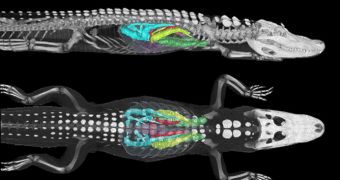The Permian-Triassic extinction event was one of the most devastating calamities ever to have hit our planet. In fact, many experts believe that this was the single instance in which life on Earth almost came to a screeching halt, and refer to this event affectionately, calling it the Great Dying. It took place some 251.4 million years ago, and, other than killing almost all living things around, it also managed to favor the emergence of some new species. A group of such animals were what we now know to be the ancestors of alligators, creatures that learned to walk on land, and adapted to this lifestyle shortly after the extinction event, Wired reports.
One of the major side-effects of the Great Dying was the fact that oxygen levels dropped significantly and very fast. In such an environment, most species that needed air to survive were killed off. But the alligator ancestors managed to survive by developing what researchers refer to as special lungs. These organs featured a one-way air flow, which was significantly different from the one humans have, for example. The archosaurs featured a respiratory system that was similar to that of modern birds. This is one of the main reasons why paleontologists believe that this ancient creatures were the common ancestors of birds and alligators alike. The two groups split some 246 million years ago.
“We think mammals were unable to compete in niches that require some athleticism and a good set of lungs. If you can’t run you better hide, and you better be small enough to hide,” C. G. Farmer, an evolutionary biologist at the University of Utah, says. He has been the leader of a new study detailing the way the ancient ancestor managed to adapt itself to a low-oxygen environment. Details of the work appear in the Thursday issue of the top scientific journal Science. The expert explains that the lungs of birds, for instance, are basically a loop, in which air flows in a single direction before being expelled back out.
This is very different from our lungs, through which air flows inside progressively smaller tubes. At the end of these tubes, there are small chambers, where the air exchanges oxygen with the blood stream, and collects carbon dioxide for elimination. This means that the air circulates both ways through the same conduits. This limits our ability to breathe in the sense that we need a certain amount of oxygen in the air to survive. Birds, on the other hand, can fly at altitudes where the low oxygen levels would kill humans. This ability stems directly from their one-way respiratory system.

 14 DAY TRIAL //
14 DAY TRIAL //